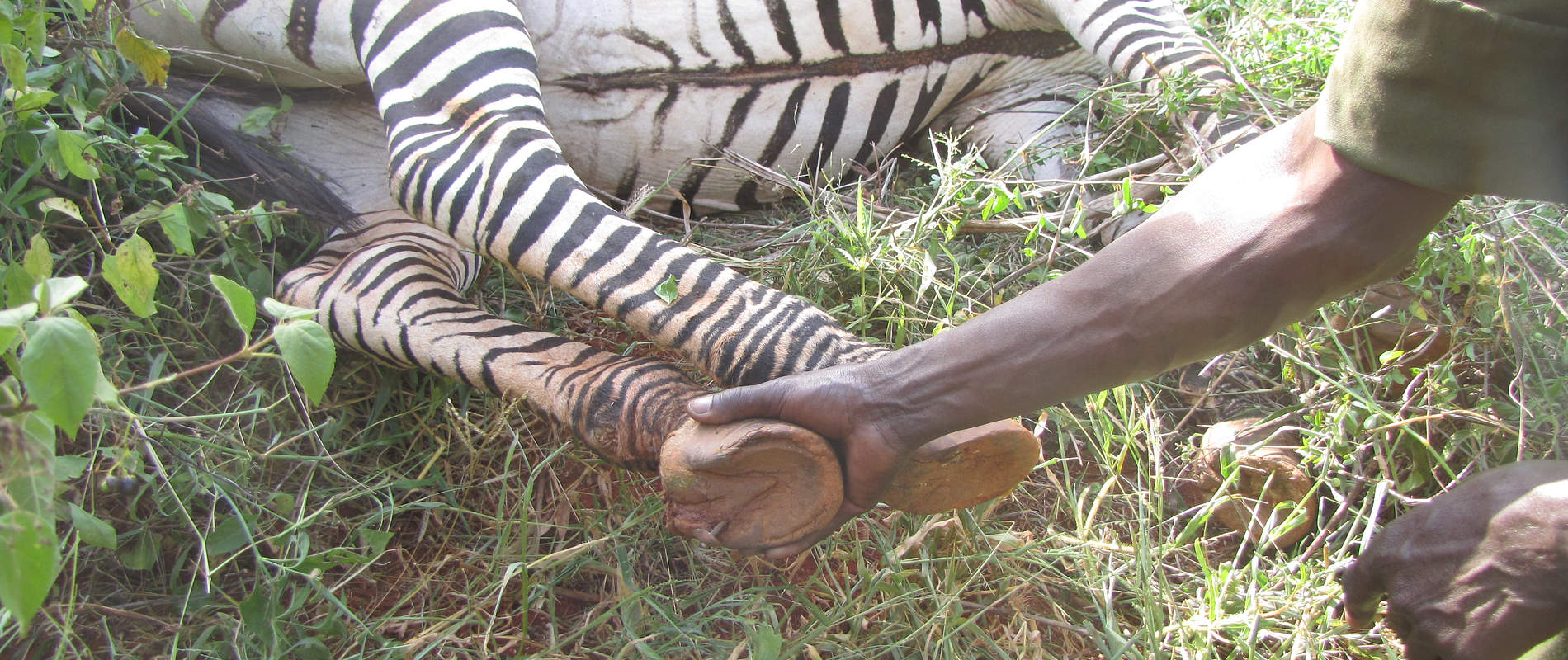FIELD VETERINARY REPORT FOR TSAVO MOBILE VET UNIT FOR THE MONTH OF JANUARY 2015 Reported By Jeremiah Poghon Introduction The unit resumed duty in mid-January after being away on annual leave since December 2014
FIELD VETERINARY REPORT FOR TSAVO MOBILE VET UNIT FOR THE MONTH OF JANUARY 2015
Reported By Jeremiah Poghon
Introduction
The unit resumed duty in mid-January after being away on annual leave since December 2014. Being midway through the month not many cases were attended as the region remained relatively calm. Cases attended included an autopsy of a suspected poached Elephant in Rukinga ranch, treatment of an elephant bull with an arrow wound in Emusaya, Tsavo east national park and a problematic leopard captured near Kilaguni Serena lodge.
CASE #1 RUKINGA ELEPHANT AUTOPSY REPORT
Date of Postmortem: 17th January 2015
Species: Elephant
Sex: Male
Age: Adult – 40 years
Location: Rukinga Ranch
History
Gun shots were heard in the area around Rukinga ranch on the evening of Friday 16th and a search was conducted in the vicinity by KWS rangers where the elephant bull carcass was located with its tusks intact. Decomposition was setting in and the carcass was already emitting a strong foul smell.
General examination
The carcass was swelling due to decomposition, the stomach was distended and a foul smell was evident. He was age at around 40 years and lay on the left side. The right side was examined with no external injury and the carcass turned to expose the left flank. The left side had two penetrating wounds near the rump and to the left shoulder. Period from death put at 2 days.
The left penetrating wound on the shoulder was opened and muscle tearing was observed, the wound was larger than ones caused by arrows or a bullet. The torn shoulder muscles were stained dark by suspected poison substance. The injury was about 15 cms deep and didn’t reach the scapula bone just below it.
The penetrating wound on the left side of the rump was also about 15 cms deep and about 3 cms in diameter. There was massive muscle tearing with darkish staining substance in the area. No object was recovered from the wound.


Conclusion
Spearing by use of poisoned spear with estimated date of death being 15th January 2015
CASE #2 TREATMENT OF AN INJURED ZEBRA
Date: 17th January 2015
Species: Common Zebra
Sex: Female
Age: Adult
Location: Manyani gate, Tsavo east
History
Immediately after the autopsy was complete, the unit received a call regarding a zebra that was limping from a nail injury to the leg. The nail injury to the hoof prevented the zebra from putting weight on the affected foot and she was walking on three limbs.


Immobilization, examination and treatment
The zebra was darted using 7 mgs of Etorphine mixed with 60 mgs of Xylazine and went down in 5 minutes. The roofing nail stuck in the hoof was pulled out, the wound cleaned and sprayed with tincture of iodine.


Long acting Amoxicillin and dexamethasone were administered by intramascular injections.


Recovery
The anaesthesia was finally reversed by administration of 24 mgs of diprenorphine Hcl and Atipemazole Hcl intravenously.


Prognosis
Prognosis is good
CASE#3 TREATMENT OF AN ELEPHANT BULL
Date: 21st January 2015
Species: Elephant
Sex: Male
Age: Adult
Location: Emusaya, Tsavo East
History
A huge elephant bull was spotted by the DSWT patrol aircraft with a wound to his flank while patrolling the Emusaya area of Tsavo East north of Galana River. The huge Tusker was alone and was monitored for a day, but didn’t move.
Immobilization, examination and treatment
The team headed to the area which is about 80 Kms from the park headquarters and easily found the huge bull near a mud hole. He was darted using 18gms of Etorphine propelled in a dan inject dart system and he moved away calmly before going down 100 metres away.


The swollen wound was caused by an arrow and was already septic. The wound was cut open, pus drained out, cleaned using a mixture of water and Hydrogen Peroxide in a ratio of 1:1 then doused with tincture of Iodine and finally covered in green clay. Dexamethasone Hcl was then administered intravenously.


Recovery
After about a 30 minute operation the anaesthesia was reversed by intravenous administration of 60 mgs of Diprenorphine Hcl into the ear vein. He was unable to wake up on his own and ropes were used to pull him onto his feet. He walked away calmly.


Prognosis
CASE #4 EXAMINATION OF A PROBLEMATIC CAPTURED LEOPARD
Date: 31st January 2015
Species: Leopard
Sex: Male
Age: Adult (old)
Location: Serena Kilaguni, Tsavo West
History
This leopard was captured after he became a threat to the visitors at Serena Kilaguni lodge in Tsavo West National Park. The leopard was trapped and brought to the Tsavo vet unit for examination and management. The leopard was examined and found to be very thin, infested with numerous blood sucking external parasites and the upper canines were worn out which is an indication of advanced age.

A decision was made to euthanize the leopard as releasing him back in to wild was not viable. He was euthanized by administration of Euthanize (Pentobarbitone sodium 20%) rapid intravenous.
Conclusion and acknowledgement
The unit would like to appreciate the support of its sponsors ViER PFOTEN through the David Sheldrick Wildlife Trust (DSWT) for their continued support. We also thank Kenya Wildlife Service through the Assistant director Tsavo conservation area and the head, veterinary and capture services department for their support.

















